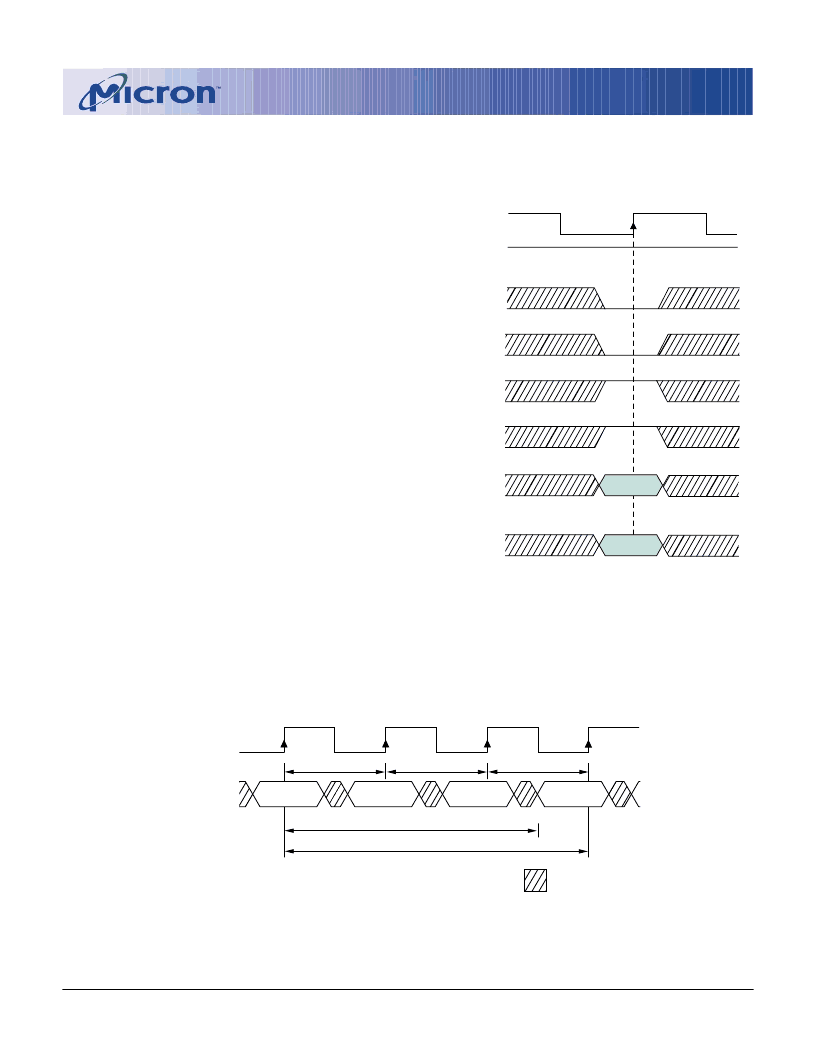- 您現(xiàn)在的位置:買賣IC網(wǎng) > PDF目錄384755 > MT48LC2M32B2 (Micron Technology, Inc.) SYNCHRONOUS DRAM PDF資料下載
參數(shù)資料
| 型號: | MT48LC2M32B2 |
| 廠商: | Micron Technology, Inc. |
| 英文描述: | SYNCHRONOUS DRAM |
| 中文描述: | 同步DRAM |
| 文件頁數(shù): | 12/53頁 |
| 文件大?。?/td> | 1818K |
| 代理商: | MT48LC2M32B2 |
第1頁第2頁第3頁第4頁第5頁第6頁第7頁第8頁第9頁第10頁第11頁當(dāng)前第12頁第13頁第14頁第15頁第16頁第17頁第18頁第19頁第20頁第21頁第22頁第23頁第24頁第25頁第26頁第27頁第28頁第29頁第30頁第31頁第32頁第33頁第34頁第35頁第36頁第37頁第38頁第39頁第40頁第41頁第42頁第43頁第44頁第45頁第46頁第47頁第48頁第49頁第50頁第51頁第52頁第53頁

12
64Mb: x32 SDRAM
64MSDRAMx32_5.p65 – Rev. B; Pub. 6/02
Micron Technology, Inc., reserves the right to change products or specifications without notice.
2002, Micron Technology, Inc.
64Mb: x32
SDRAM
Operation
BANK/ROW ACTIVATION
Before any READ or WRITE commands can be is-
sued to a bank within the SDRAM, a row in that bank
must be “opened.” This is accomplished via the AC-
TIVE command, which selects both the bank and the
row to be activated. See Figure 3.
After opening a row (issuing an ACTIVE command),
a READ or WRITE command may be issued to that row,
subject to the
t
RCD specification.
t
RCD (MIN) should
be divided by the clock period and rounded up to the
next whole number to determine the earliest clock edge
after the ACTIVE command on which a READ or WRITE
command can be issued. For example, a
t
RCD specifi-
cation of 20ns with a 125 MHz clock (8ns period) results
in 2.5 clocks, rounded to 3. This is reflected in Figure 4,
which covers any case where 2 <
t
RCD (MIN)/
t
CK - 3.
(The same procedure is used to convert other specifi-
cation limits from time units to clock cycles.)
A subsequent ACTIVE command to a different row
in the same bank can only be issued after the previous
active row has been “closed” (precharged). The mini-
mum time interval between successive ACTIVE com-
mands to the same bank is defined by
t
RC.
A subsequent ACTIVE command to another bank
can be issued while the first bank is being accessed,
which results in a reduction of total row-access over-
head. The minimum time interval between successive
ACTIVE commands to different banks is defined by
t
RRD.
Figure 4
Example: Meeting
t
RCD (MIN) When 2 <
t
RCD (MIN)/
t
CK - 3
CLK
T2
T1
T3
T0
t
COMMAND
NOP
ACTIVE
READ or
WRITE
NOP
RCD (MIN)
tRCD (MIN) = 20ns, tCK = 8ns
tRCD (MIN) x tCK
where x = number of clocks for equation to be true.
tRCD (MIN) +0.5 tCK
tCK
tCK
tCK
DON’T CARE
Figure 3
Activating a Specific Row in a
Specific Bank
CS#
WE#
CAS#
RAS#
CKE
CLK
A0–A10
ROW
ADDRESS
HIGH
BA0, BA1
BANK
ADDRESS
相關(guān)PDF資料 |
PDF描述 |
|---|---|
| MT48LC32M8A2 | SYNCHRONOUS DRAM |
| MT48LC16M16A2 | SYNCHRONOUS DRAM |
| MT48LC64M4A2 | SYNCHRONOUS DRAM |
| MT48LC4M32B2 | SYNCHRONOUS DRAM |
| MT48LC4M32LFFC | SYNCHRONOUS DRAM |
相關(guān)代理商/技術(shù)參數(shù) |
參數(shù)描述 |
|---|---|
| MT48LC2M32B2-6G | 制造商:Micron Technology Inc 功能描述: |
發(fā)布緊急采購,3分鐘左右您將得到回復(fù)。